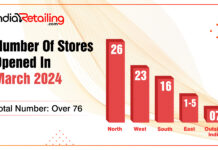By using RFID-enabled trays at SreeThangam Jewellery,the jewellery format of The Chennai Silks, has been able to achieve faster checkouts and higher productivity
By Anurima Das
The Chennai Silkshas been delightinggenerations of families. Having evolved from a humble khadi store into a chain of multi-storied department stores across Tamil Nadu, the 62-year old brand recently ventured into the jewellery segment with SreeThangam Jewellery stores.
The brand has managed to strike the delicate balance between upholding the values of its founder A. KulandaivelMudaliarand moulding itself to the changing times and consumer preferences. It has embarked on a journey of tech-adoption across its brands. The brand is now focusing on enabling its jewellery format with the latest in tech.
Tech implementations
The brand recently implementedbilling and inventory management and maintenance software to streamline product assessment and categorization.
Furthermore, the company also adopted RFID technology at its jewellery stores Tirupur, Madurai andDindigul, with an aim tostreamlining management of its jewellery units. Santhosh Sundarraj, Head IT, The Chennai Silks shared the company has introduced RFID trays at the stores that have simplified the entire process of browsing till checkout.
This implementation has been done keeping in mind the COVID measures and helps avoid contact as much as possible. However, there are other benefits to using the technology.
“RFID helps us access information about a product a customer is interested in such as its weight, wastage, carat etc in a moment, just by placing the item on the tray. From weight to wastage to other measures and qualities of the product are displayed quickly when placed on the tray,” he explained.
In addition, the RFID implementation has made checkouts faster for the customer visiting the brand stores and it ensures faster billing offering a seamless customer experience.
Apart from RFID, the stores also use tablets to help customers browse the entire collection. “Instead of displaying a large number of products, we use tablets and other portable devices to give the customers a sense of the product range. These units are mounted across the store and customers can access them in minutes to browse our collection, without having to try the pieces individually,”Sundarraj added.
Improved efficiency
“Before the implementation of RFID, we used to check the entire stock at the end of the day and take a manual check on the products to understand how many pieces of each design have been sold and what’s in stock,” explained the IT head.
“The process was cumbersome and with growing inventory, it became very chaotic to maintain the stock manually,” he added.AdoptingRFID changed all that.
Furthermore, the RFID has been integrated with other systems as well such as the ERP and the company’s stock maintenance system. Sundarraj informed that is also able to rope in customer feedback on products on the same platform. “Moreover, we are able to integrate and bring the customer data also on one platform,” he added.
Further enhancements
Integration is big on the brand’s mind and the team is looking for ways to make the huge inventory across categories more accessible to the customer and the internal team across touchpoints by sealing in technology at the right points and connecting each node with the right plug-ins. To offer the perfect connectedness to the audience, the brand is trying to implement a centralized system of PLM. Once put into action this will not only bring the entire inventory all across stores on the same platform but will help all the stores manage stock and keep a tab on inventory in real time.
“Finalizing samples and going by the evolving trends to launch a new range or collection each time is a big task. Especially when we have so many segments to cater to. Each individual customer is different and so is each segment and age group. So, at this point, we want to activate the right technology to be able tofollow the trends in real-time and thereby instantly apply that to production and get everything as per trends, right on time. This is where a PLM system will work wonders. But the implementation and how to integrate it the right way for better optimization is a big task,” Santhosh informs.
With many new implementations in place and the customer looking at a connected experience, a good chunk of sales is coming from the online space, the IT head informed. However, the brand is looking to ramp up its online presence and increase the way it is approaching inventory online to offer the customer a better experience. Shuffling through the huge inventory is a task and that’s why the brand is building several personalized aspects to allow the customer to pick and choose quickly and with ease. This will get sharper with time.
In jewellery, customer is not always willing to spend a huge amount online. That’s where the omnichannel experience and the right technology will help in bringing the customer to the store to choose the same product, experience it, and shop at their convenience.
Moreover, from here on the brand is fully focused on building its online presence and visibility. While traditional marketing methods are on the cards and they are ready to win customers using the ATL/BTL route, Santhosh and his team want to increase the brand’s online presence by penetrating marketplaces. The brand wants to increase its inventory on other online channels too. Further, an application may be on the cards to increase the brand’s touchpoints even further and help it build a quick and connected customer interface in no time.
The Chennai Silks is household name in Tamil Nadu. The department store, often, several stories large are in Tirupur,Coimbatore, Erode, Chennai, Trichy, Karur, Ernakulam, Tirunelveli, Vellore, Salem, Madurai, Villupuram, Hosur, Chittoor, Dindigul, Hyderabad, Kumbakonam, Tuticorin, Tanjore, Pondicherry.
The brand also caters to shoppers in 200 countries through thechennaisilks.com.







